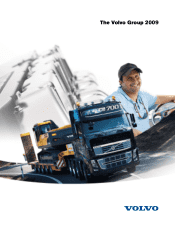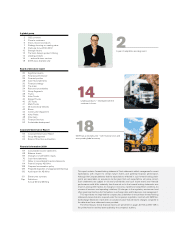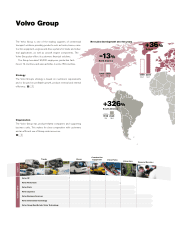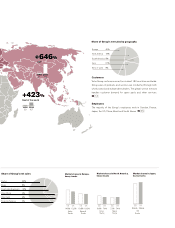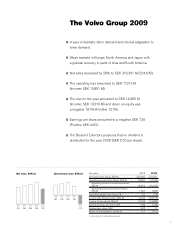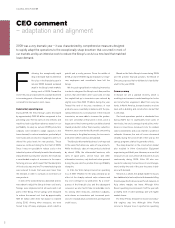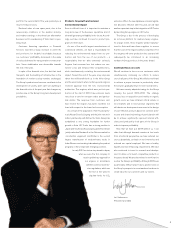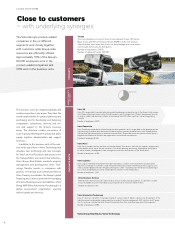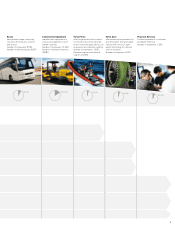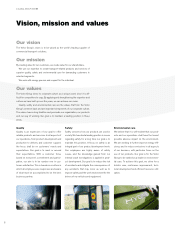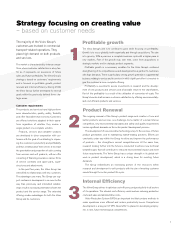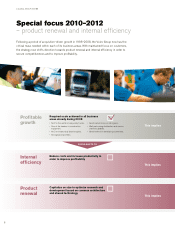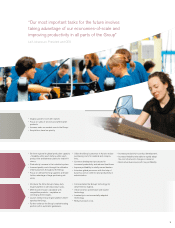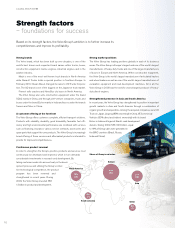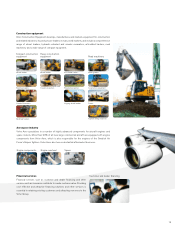Volvo 2009 Annual Report Download - page 7
Download and view the complete annual report
Please find page 7 of the 2009 Volvo annual report below. You can navigate through the pages in the report by either clicking on the pages listed below, or by using the keyword search tool below to find specific information within the annual report.
prot for the second half of the year, primarily as a
result of reduced costs.
Reduced sales of new spare parts, due to the
recessionary conditions in the aviation industry,
and weaker earnings in the American aftermarket
business led to a weakening of Volvo Aero’s oper-
ating result.
Customer nancing operations in Financial
Services reported a sharp increase in write-offs
and provisions for doubtful receivables because
our customers’ protability decreased in the wake
of reduced demand for transportation in many mar-
kets. Some stabilization was discernible towards
the end of the year.
In spite of the nancial crisis, the fact that truck
transports and the building of infrastructure is the
foundation of modern society remains unchanged.
The Group’s products and services contribute to the
development of society, and I can’t see anything in
the nancial crisis of the past year that changes my
positive view on the Group’s long-term development
possibilities.
Products for growth and reduced
environmental impact
Even in difcult times it is important to maintain a
long-term view of the business operations and of
what will generate protability in the future. Accord-
ingly, we have continued to invest in product pro-
grams for the future.
As one of the world’s largest manufacturers of
commercial vehicles, we have a responsibility for
reducing the environmental impact from our pro-
duction and from the use of our products – a
responsibility that we take extremely seriously.
Engines that consume less fuel reduce our cus-
tomers’ costs and enhance their competitiveness,
while simultaneously curtailing the environmental
impact. Toward the end of the year, a key step was
taken that will benet both us in the Volvo Group
and the environment, when our Group-wide engines
received approval from the U.S. environmental
authorities. The engines, which were put into pro-
duction at the start of 2010, have emission levels
very close to zero for nitrogen oxides and particu-
late matter. The response from customers who
have tested the engines has been excellent, not
least with respect to the lower fuel consumption.
As a result of the acquisition of UD Trucks (previ-
ously Nissan Diesel), Lingong and the joint venture in
India in partnership with Eicher, the Volvo Group has
established a very strong foundation for further
growth in Asia. UD Trucks has a strong position in
Japan and Southeast Asia, Lingong and Volvo CE are
jointly ranked as Number 4 in the Chinese market for
construction equipment and Eicher is the second
largest manufacturer of medium-heavy trucks in
India. We are now investing in broadening the product
programs in these important emerging countries.
In early 2010 we took a step ahead in Japan,
when we were the rst company to
receive preliminary approval for
our engines in accordance
with the country’s new emis-
sion regulations, which are
the rst in the world to
stipulate levels for CO2
emissions. When the new Japanese emission legisla-
tion becomes effective later this year, we will take
another important step in the integration of UD Trucks
by launching Group engines in UD trucks.
The Group is also in the process of developing
an in-house platform for medium-heavy engines.
To a large extent, these engines will be manufac-
tured in Asia and have Asian suppliers to ensure
that the cost of the engines will be competitive. The
rst engines will enter production this year and will
subsequently be introduced in an increasing
number of Group products in the years ahead.
Continued focus on costs
We will continue to focus on our customers, while
simultaneously continuing our efforts to reduce
costs in all parts of the Group. We will also work hard
to achieve a proper increase in productivity, when
the volumes gradually return to more normal levels.
We have a newly adopted strategy for the Group
covering the period 2010–2012. The strategy
focuses less on acquisitions and mainly on organic
growth, since we have attained critical volume in
most markets and in most product segments. We
will devote our development resources to the design
of cost-effective products based on common archi-
tecture and shared technology. A particular aim will
be to achieve signicantly improved internal ef-
ciency and productivity in all parts of the Group in
order to improve protability.
Now that we have put 2009 behind us, I can
state that although demand remains at low levels
from a historical perspective, we have reduced our
costs substantially, cut back on our inventories and
reduced our capital employed. We have a healthy
liquidity and low renancing requirements. We have
also continued to invest in research and develop-
ment to allow us to launch competitive products in
the years ahead. We are determined to work hard to
restore the Group’s protability. Although 2009 was
a particularly difcult year, I have a positive view on
the Group’s prospects to come back and continue to
create value for our customers and our owners.
Leif Johansson
President and CEO
3

